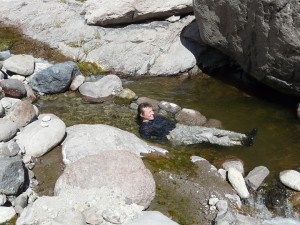
There is something deeply primal about the allure that hot springs have over people. Just where within our psyche or corporeal being this attraction lies we may never know. Yet for most of us, it is there. Latent, perhaps, until one comes upon that first warm seep or gush of hot water bubbling up mysteriously from somewhere deep below. Cool springs encountered in the wild don’t appear to have the same effect. While interesting and refreshing, and certainly much appreciated on a long dusty trail on a hot summer day, cool springs do not seem to trigger the deeper emotional response as geothermal hot springs. As humans, we are drawn to warmth. We prefer sitting by the fire instead of in a cold corner; we enjoy hot showers, but endure cold ones. Our bare skin relishes the warmth of the summer breeze, but shrinks from the cold wind on a raw winter’s day. Could it be just a comfort thing, this attraction that drives us to struggle for miles over rough terrain in the pursuit of that one more distant hot spring? For some, perhaps, that is all it is, just another pursuit of pleasure. But for many it seems to be something far more, something that resonates at a much deeper level, the ineffable feeling that overcomes one while soaking in a hot pool in the middle of Wilderness …
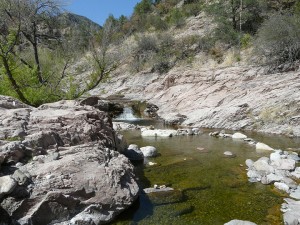
The Gila Wilderness and surrounding Gila National Forest are blessed with numerous hot springs, most in untrammeled, pristine Wilderness. Some are well known and can be accessed easily, such as the Gila Hot Springs located just off State Highway 15 on the way to the Gila Cliff Dwellings, or Lightfeather Hot Springs (aka Middle Fork Hot Springs) a half-mile hike from the visitor center at the Gila Cliff Dwellings. Others are less well known, requiring moderate to difficult hikes in rugged country, such as Jordan Hot Springs, about 8 miles up the Middle Fork of the Gila River, or Turkey Creek Hot Springs, on the south side of the Gila Wilderness.
Yet as special as these and other known hot springs are, for many it is the mystique surrounding the unknown hot springs of the Gila that brings them back to this rugged landscape again and again, each time being drawn ever further into this very special Wilderness in search of what they know must be there. As one slowly begins to unravel and understand the ancient volcanic history of this little-known Gila backcountry, the realization soon comes that there must be countless other geothermal seeps, hot springs, and pools out there, their location long forgotten, places now visited only by the birds and animals. That is unless you are willing to consider the spirits of a hundred generations of Native Americans, and more recently, perhaps, the spirits of a few frontier prospectors or hermits who once called the Gila home.
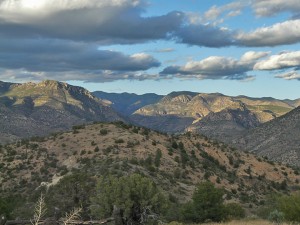
Turkey Creek Hot Springs are not far from Casitas de Gila Guesthouses, only about 11 miles as the crow flies. However for us less-feathered-endowed mortals to get there and back, it will require a difficult physical journey, plus a good 10 hours of time. Though not for the faint of heart or the out of shape, a visit to the Turkey Creek Hot Springs promises the intrepid hiker or naturalist an intimate and inspirational sojourn into the very essence of the incredible Gila Wilderness. As special as this hike is, though, it is critical to know that access to the Turkey Creek Hot Springs is NOT always possible. High water and length of daylight hours are the two limiting factors, the most favorable times of the year being April through late June, and late September through early November. During these times the Spring runoff and the Summer rains and flash floods are generally not a problem; plus, there are enough daylight hours for a one-day visit. This is remote, rugged Wilderness and visitors who are not from the area are strongly advised to check with local authorities (such as the Gila National Forest District Ranger Station in Glenwood) before attempting a trip to the Turkey Creek Hot Springs.
I had been hearing about the wonders of Turkey Creek Hot Springs ever since we came to live here 12 years ago, but not until last week did I finally have the opportunity to visit them with my good friend and neighbor Bill Marcy and a couple of his visiting family members, John and Becky. Bill is a local hiking guide in our area, and enjoys taking tourists and visitors to special, out-of-the-way places, such as the Turkey Creek Hot Springs.
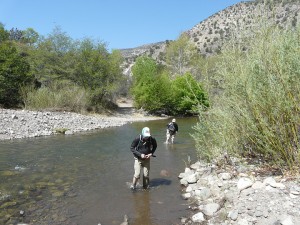
The drive to the trail head from Casitas de Gila Guesthouses takes close to an hour. The first five miles pass quickly, driving through hilly ranch land covered with juniper, piñon and mesquite, along the less-travelled portion of Hooker Loop before returning to State Road 153 (aka Turkey Creek Road). Turning north towards the mountains, SR 153 soon becomes Forest Road 155 (still aka Turkey Creek Road). For the next nine miles one travels a rough, winding, gravel road that leads deep into the Gila National Forest. While a 4-wheel drive vehicle is not necessary, high clearance, good tires, and good brakes are strongly advised. Leaving the Gila Valley, FR 155 climbs abruptly and steeply into the lower hills and mountains of the Piños Altos Range to top out along a mile-long grassy ridge at 5,800 feet, sparsely vegetated with piñon, juniper, prickly pear cactus, and sotol agave. Upon ascending this ridge, one immediately encounters a most spectacular panoramic view extending every direction. So incredible is this view that it is impossible not to stop and get out to experience fully the vast natural grandeur of the Gila.
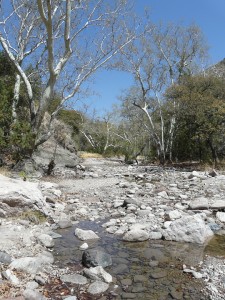
Looking north, the interior mountain peaks of the Gila Wilderness soar majestically upward from the deep canyon tracing the course of the Gila River hidden far below. To the east rocky cliffs of Gila Conglomerate outline the course of the Bear Creek drainage basin stretching upstream some 20 miles to Piños Altos, a few miles north of the volcanic peak of Bear Mountain looming on the far horizon. Five miles to the south, Turtle Rock and Telephone Mountain mark the location of Casitas de Gila Guesthouses in Bear Creek Canyon below, and further on the undulating range of the Burro Mountains makes up the southern skyline. Now turning to the west, the eye is treated to the verdant course of the Gila Valley that can be traced for miles, the Gila River itself hidden deep amongst the ancient cottonwoods lining its banks. Standing there, an awareness soon creeps into one’s consciousness that here, spread out in every direction, is the essence of Southwest New Mexico, and it is indeed a Land of Enchantment!
Continuing on, the road now drops off the ridge and begins a long and winding descent into Brushy Canyon, to eventually bottom out on the Gila River Floodplain where the trailhead to Turkey Creek Hot Springs is waiting. In years past it was possible to drive another half mile before coming to the first fording of the Gila River. But now, due to a portion of the road being washed out during a flood, a barricade of large boulders announces that it’s time to park Bill’s Bronco and start hiking.
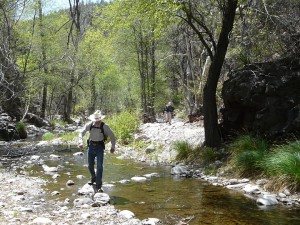
The first half mile of the trail takes us along the remainder of the washed-out road, passing beneath the arching branches of a grove of ancient cottonwood and white-trunked sycamore, the cottonwoods resplendent in their new yellow-green leaves. Soon we encounter a calf-deep ford crossing the Gila River, the first of three that must be crossed before reaching the mouth of Turkey Creek Canyon. A couple of our party pause to change into canvas footwear which they will wear until the final crossing is left behind. The clear water is rather cold, but unnoticed in the warm, late morning sun, the eastern peaks before us gleaming and beckoning us onward.
The last crossing is soon reached, the deepest of the three, but still only up to one’s knees. At this point the trail leaves the River and enters Turkey Creek Canyon. Almost immediately we come to the remains of an old wooden corral and loading chute, an ancient windmill, and a couple of collapsing buildings, remnants of ranching days gone by, now all but reclaimed by the encroaching Wilderness.
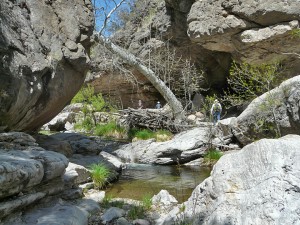
The trail up Turkey Creek is a journey of indescribable beauty. Mostly sticking to the west bank of the creek, it leads us on a marvelous Spring adventure into an ever-deepening canyon of vertical, multicolored volcanic walls that soar into the cobalt sky beneath the eccentric tangle of bone- white branches of mature sycamore reaching for the sky, their Spring buds just starting to swell. At first only a trickle, the flow of Turkey Creek slowly increases as we make our way northward. The canyon gradually narrows as the boulders of volcanic welded tuff scattered within and along the creek increase in size and number.
Two miles up Turkey Creek we come to a lovely, spacious, and inviting camping area on the west side of the Creek within a delightful grove of mixed pine and hardwood. The canopy of piñon, gray oak, walnut, ponderosa, sycamore, and ash provide a cool, shady respite from the warming sun. It is obvious from the old rock-lined fire pits that this has been a favorite camping site for many, many years. Yet it has been well cared for by those who stopped here, with no trash in sight anywhere.
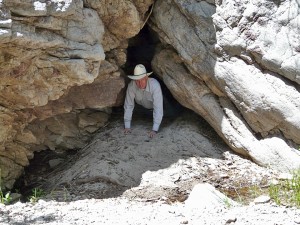
A couple of hundred yards past the camping spot we come to the only critical fork in the trail for those seeking the Turkey Creek Hot Springs. Very easily missed, and only marked with a couple of small cairns of stacked rocks, the little-used trail to the hot springs forks off to the right while the more heavily-used Skeleton Canyon Trail bears to the left before crossing the dry wash at the mouth of Skeleton Canyon, and then begins a steep climb up a series of switchbacks to continue north along a high ridge between Turkey Creek Canyon and Skeleton Canyon. We take the right fork and continue up Turkey Creek Canyon, which immediately becomes narrower and more difficult to traverse.
The trail soon achieves faint to non-existent status, requiring increasing amounts of scrambling over large boulders and precipices and back and forth rock hopping across shallow, crystal clear pools in the Creek. But as the pace slows and the difficulty of forward progress increases, the physical beauty of the journey increases proportionately. Large, recessed alcoves of overhanging rock and layered ledges of black, shattered, glassy volcanic rock called vitrophyre, with enclosed splatter-shaped inclusions of deep red jasper-like material and crystal-lined geodes, repeatedly slow this geologist’s progress to a standstill. Entering the Narrows, we slowly pick our way along the rocky cliffs now extending to the water’s edge. And then, there it is: The Keyhole, through which all seekers of the Springs must pass, crawling and wiggling on one’s belly like a snake, praying with each wiggle and grunt that the real ones are not around and that we are indeed as slim as we think we are! Once safely through the keyhole, one is immediately confronted with another challenge: The Squeeze, a 100-foot-long narrow cleft of delightful scrambling consternation.
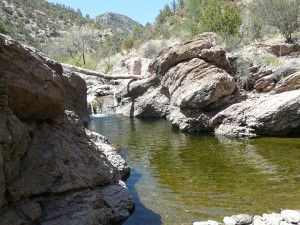
Once past the squeeze, the way becomes easier. After a final tenth of a mile and negotiating one last rocky ledge, a deep, elongated pool, complete with a rock slide and waterfall at its upper end, announces that we are there: Turkey Creek Hot Springs!
What a marvelous and fascinating place! A series of pools, some completely natural, some enhanced with hand-laid rock dams, stretch upstream from the elongated pool. The various sized pools offer enough variation in temperature to satisfy even a hiking Goldilocks, ranging from too hot to too cold to just right. The control for the variation is, of course, Mother Nature herself, as the cold waters of Turkey Creek mix with the 150–165 degree geothermal waters that seep, flow, and bubble from innumerable cracks and crevices both within the smooth rock and sandy bottoms of the pools and from the adjoining rock ledges.
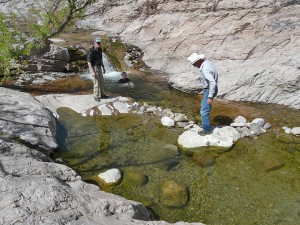
As with all warm and hot springs, wherever they are found around the globe, the hot springs of the Gila do have the amoeba Naegleria fowleri, which are extremely dangerous to humans if allowed into the nasal passages, causing primary amoebic meningoencephalitis or PAM. While infection is extremely rare, it is usually deadly. According to the medical experts, the amoeba can only enter through the nose, so keeping one’s head out of the water or wearing a nose clip is considered sufficient protection (more detailed info in references below).
What is the source of these hot waters, one might wonder? Well, far beneath Turkey Creek Hot Springs, as well as beneath most of the Gila Wilderness, lies the now solidified, but still slowly cooling, magma chamber that once fed the repeatedly explosive volcanic Bursum Caldera and its northern neighbor the Gila Cliff Dwellings Caldera some 28 million years ago. The evidence for these massive eruptions is the thick deposits of volcanic pyroclastic flows and welded tuffs that are found throughout the Gila Wilderness and through which we have travelled this entire day. But here, deep within Turkey Creek Canyon, even more tangible are the hot springs themselves, a sensuous, primal reminder of just how wild this part of the West once was.
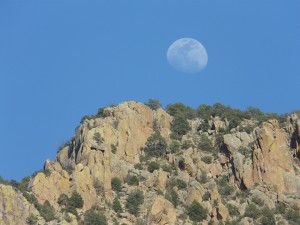
A well-earned leisurely lunch is followed by a closer land inspection of the various pools by Bill, John, and myself, leaving Becky to conduct a systematic aquatic survey of the thermal variation of several of the more inviting pools and natural water slides. Great fun!
The trip back goes quickly, more direct since we know the way; 4.5 miles as opposed to the 5 mile hike in according to the GPS. In two hours of fast hiking, we arrive at the Gila River, where, just as we begin our first ford, we come across some large, fresh mountain lion tracks right where we had passed that morning. What a great reminder they are of the Wilderness that we have travelled today, that there are places where the imprint of Nature still reigns supreme. Just as we arrive back at Bill’s Bronco, a near-full moon rises over the volcanic rock cliffs, now golden in the setting sun. Wow! How perfect is that!
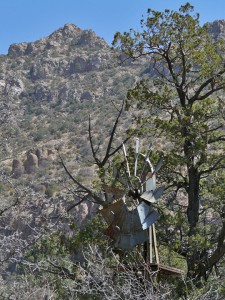
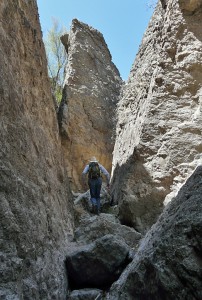
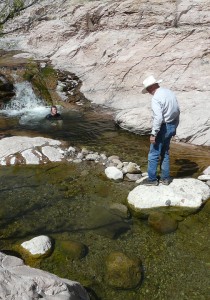
References:
http://en.wikipedia.org/wiki/Hot_spring
http://www.southernnewmexico.com/Articles/Southwest/GilaWilderness/HotspringsintheGilaNation.html
http://www.nps.gov/gicl/naturescience/hotsprings.htm
http://geoheat.oit.edu/bulletin/bull23-4/art6.pdf


